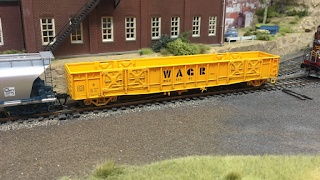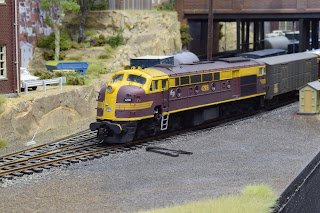A carriage set I've always been fascinated by but which has been so far out of my era that I couldn't justify a purchase was the RAAF Recruiting Train. There were two, three-car sets in total, and Set 25B ran all over the state between 1940 and 1942, pretty much doing what the advertisement suggested - "Walk in one end a farmer and out the other a signed up member of the Air Force."
I had started collecting Camco FO kits to one day build this train myself, but the part where I'd need to get custom decals had me stumped. I just didn't know who I could go to to get some made up. Fast forward a few years and SDS models have upgraded the Austrains NSW 'cowboy' cars, releasing a set in the RAAF Recruiting Train livery under their Austrains Neo brand.
I had started collecting Camco FO kits to one day build this train myself, but the part where I'd need to get custom decals had me stumped. I just didn't know who I could go to to get some made up. Fast forward a few years and SDS models have upgraded the Austrains NSW 'cowboy' cars, releasing a set in the RAAF Recruiting Train livery under their Austrains Neo brand.
I picked up this set a few days ago from Casula Hobbies and after a bit of reading on the history of the cars wanted to correct some minor things to get them more accurate and closer to the prototype. Straight out of the box, this is what you get:

According to a History of RAAF Recruiting Trains by R.I. Merchant (published on SDS' Austrains Neo website), the cars were sky blue with silver roofs. I could also see in a few of the pictures the exhaust for a generator which was housed in the guards' compartment to power refrigerators and other equipment on the train.
I fashioned an exhaust outlet from a spare kit sprue, reducing the size of the end to give it some shape with a file. After drilling a hole in the roof by eye going from photos, this was duly fitted.
I fashioned an exhaust outlet from a spare kit sprue, reducing the size of the end to give it some shape with a file. After drilling a hole in the roof by eye going from photos, this was duly fitted.


Next the car was masked for spraying. Having learned the lesson of using too much tape on the 421, I stuck the tape onto paper where it would come into contact with the car, save for about 5mm at the top where it would need to stick onto the car.
A spray with Tamiya TS-30 silver leaf and voila!
I finished masking and spraying the other two cars this afternoon and now the whole set is complete as per the title photo.
To make it even more accurate, I would need to replace the buffers on the outer ends of the set with the longer type, and fit the cars with hook and link couplers. I've seen the latter done, but I'm not quite ready to jump into that yet.
I'm tossing up whether to make a short diorama for the cars to sit in a siding somewhere, but that would need to come after I've solved the main problem of the next layout.
Until next time, best wishes for the rest of 2018.
I'm tossing up whether to make a short diorama for the cars to sit in a siding somewhere, but that would need to come after I've solved the main problem of the next layout.
Until next time, best wishes for the rest of 2018.
Cheers,
Ben


















































